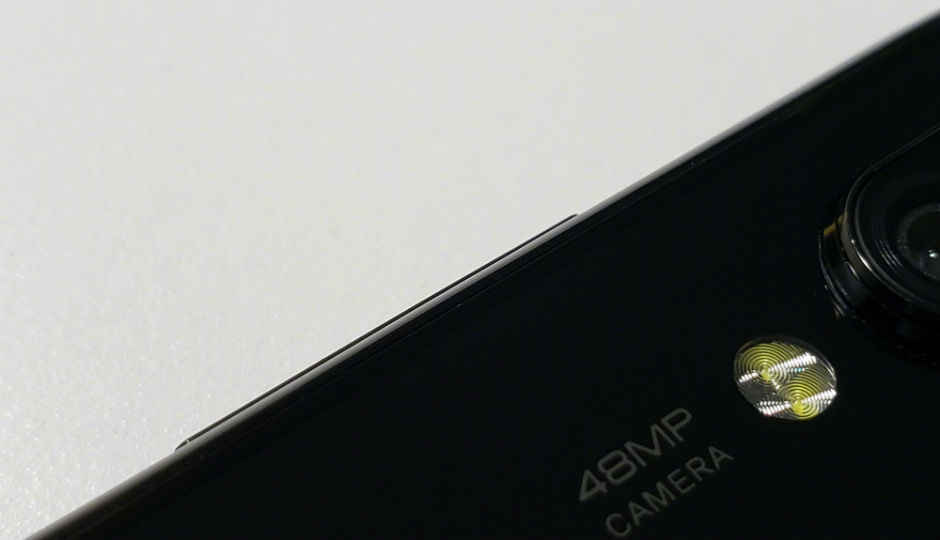 Highlights: Moto Z4 Play leaked renders show Waterdrop notch The phone is seen carrying one camera each on the front and rear There is no visible fingerprint sensor Motorola is speculated to be working on the G-Series of smartphones but a new report has revealed the company’s other project, the Moto Z4 Play. Tech news website CompareRaja, in association with OnLeaks, leaked the first 3D renders and 360-degree video of the smartphone showing a waterdrop notch, a camera bump and magnetic connection pins on the bottom of the back panel to attach the Moto Mods. The images revealed by the news platform also show the rumoured device carrying a USB Type-C port for charging and a 3.5mm headphone jack, which some companies are now removing from their smartphones. Interestingly, the renders show the smartphone sporting only two cameras: one on the front and one on the back. If true, a single camera on the back is a downgrade from the Moto Z3 Play, which had a dual-camera setup on the rear panel. However, if it's as good as the Pixel 2's single camera setup, then it could be worth it. The rear camera and LED flash are housed inside the usual bump that has been seen in most Motorola-branded phones. There is a Motorola logo below the rear camera and there are mod connecting pins below the logo. There is no visible fingerprint sensor which could mean that the phone might come with an in-display fingerprint sensor or no sensor at all and opt to only include face unlock. There is a speaker grille on the top edge and the volume rocker as well as the power button are on the right edge of the phone. CompareRaja says that the dimensions of the device are 158 x 75 x 7.25 mm (9.4mm including rear camera bump) and the display size is roughly 6.2-inches. There is no information on the variants and colour options in the report, however, it mentions that the company could launch a 5G Moto Mod with the phone. Related Read: Motorola might announce Moto G7 phones in Brazil ahead of MWC Moto G7 series devices leaked in press renders
Highlights: Moto Z4 Play leaked renders show Waterdrop notch The phone is seen carrying one camera each on the front and rear There is no visible fingerprint sensor Motorola is speculated to be working on the G-Series of smartphones but a new report has revealed the company’s other project, the Moto Z4 Play. Tech news website CompareRaja, in association with OnLeaks, leaked the first 3D renders and 360-degree video of the smartphone showing a waterdrop notch, a camera bump and magnetic connection pins on the bottom of the back panel to attach the Moto Mods. The images revealed by the news platform also show the rumoured device carrying a USB Type-C port for charging and a 3.5mm headphone jack, which some companies are now removing from their smartphones. Interestingly, the renders show the smartphone sporting only two cameras: one on the front and one on the back. If true, a single camera on the back is a downgrade from the Moto Z3 Play, which had a dual-camera setup on the rear panel. However, if it's as good as the Pixel 2's single camera setup, then it could be worth it. The rear camera and LED flash are housed inside the usual bump that has been seen in most Motorola-branded phones. There is a Motorola logo below the rear camera and there are mod connecting pins below the logo. There is no visible fingerprint sensor which could mean that the phone might come with an in-display fingerprint sensor or no sensor at all and opt to only include face unlock. There is a speaker grille on the top edge and the volume rocker as well as the power button are on the right edge of the phone. CompareRaja says that the dimensions of the device are 158 x 75 x 7.25 mm (9.4mm including rear camera bump) and the display size is roughly 6.2-inches. There is no information on the variants and colour options in the report, however, it mentions that the company could launch a 5G Moto Mod with the phone. Related Read: Motorola might announce Moto G7 phones in Brazil ahead of MWC Moto G7 series devices leaked in press rendersfrom Latest Technology News http://bit.ly/2Rw65Ho
 CES 2019 is just around the corner and we expect to see the launch of a number of gadgets at the event. Sony has announced that it will hold its press conference on January 7 and the company is expected to announce a refresh to its TV lineup, smartphones, portable speakers and more. If information circulating the internet is to be believed, then Sony is expected to announce the Xperia XA3, XA3 Ultra, and the Xperia L3 at the event. Sony has a history of showcasing smartphones at CES, however, most smartphone manufacturers showcase their offerings at MWC. The Sony Xperia XA3 and Xperia XA3 Ultra phones have been a part of the rumour mills for some time. There is no official information available about the specifications of the smartphones. However, as far as rumoured specifications are concerned, the Xperia XA3 and Xperia XA3 Ultra will run on Android 9 Pie out of the box. As we have seen with other Sony smartphones, it is expected that the power button will be on the side of the device and double up as a fingerprint sensor. The smartphones are expected to house dual cameras at the back. Under the hood, it is speculated that the devices will have the Qualcomm Snapdragon 660 processor coupled with 6GB of RAM and 64GB built-in storage. The XA3 is expected to sport a 5.9-inch 18:9 display with a resolution of 1080x2160 pixels whereas the Sony Xperia XA3 Ultra is expected to sport a 6.5-inch 18:9 display with a resolution of 1080x2160 pixels. As far as the Xperia L3 is concerned, it is speculated to have a 5.7-inch HD+ 18:9 display with a resolution of 720x1440. As far as battery is concerned, the Xperia L3 is expected to sport a 3400mAh battery and will be powered by a Qualcomm Snapdragon 660 SoC. It is expected to have a 13+5MP dual-camera setup on the back. Apart from smartphones, Sony usually showcases TVs, IoT devices, speakers and more at CES. CES kicks off on January 8 and will end on January 11. Press conferences are held a day or two before the show floors open. Stay tuned as we will bring you all the developments from the show floor.
CES 2019 is just around the corner and we expect to see the launch of a number of gadgets at the event. Sony has announced that it will hold its press conference on January 7 and the company is expected to announce a refresh to its TV lineup, smartphones, portable speakers and more. If information circulating the internet is to be believed, then Sony is expected to announce the Xperia XA3, XA3 Ultra, and the Xperia L3 at the event. Sony has a history of showcasing smartphones at CES, however, most smartphone manufacturers showcase their offerings at MWC. The Sony Xperia XA3 and Xperia XA3 Ultra phones have been a part of the rumour mills for some time. There is no official information available about the specifications of the smartphones. However, as far as rumoured specifications are concerned, the Xperia XA3 and Xperia XA3 Ultra will run on Android 9 Pie out of the box. As we have seen with other Sony smartphones, it is expected that the power button will be on the side of the device and double up as a fingerprint sensor. The smartphones are expected to house dual cameras at the back. Under the hood, it is speculated that the devices will have the Qualcomm Snapdragon 660 processor coupled with 6GB of RAM and 64GB built-in storage. The XA3 is expected to sport a 5.9-inch 18:9 display with a resolution of 1080x2160 pixels whereas the Sony Xperia XA3 Ultra is expected to sport a 6.5-inch 18:9 display with a resolution of 1080x2160 pixels. As far as the Xperia L3 is concerned, it is speculated to have a 5.7-inch HD+ 18:9 display with a resolution of 720x1440. As far as battery is concerned, the Xperia L3 is expected to sport a 3400mAh battery and will be powered by a Qualcomm Snapdragon 660 SoC. It is expected to have a 13+5MP dual-camera setup on the back. Apart from smartphones, Sony usually showcases TVs, IoT devices, speakers and more at CES. CES kicks off on January 8 and will end on January 11. Press conferences are held a day or two before the show floors open. Stay tuned as we will bring you all the developments from the show floor.  Key Highlights: Juno captured new images of Io, Jupiter's most volcanic moon Moon Europa provides unique lighting condition New images of Jupiter’s fourth-largest moon Io have been captured by NASA’s Juno spacecraft on its seventeenth flyby of the giant gas-filled planet. On December 21, a team of scientists at the Southwest Research Institute's Space Science and Engineering Division trained four of Juno’s cameras on Io for an hour to view its polar regions and active eruptions. Juno’s imaging system consists of JunoCam, the Stellar Reference Unit (SRU), the Jovian Infrared Auroral Mapper (JIRAM), and the Ultraviolet Imaging Spectrograph (UVS). Volcanic plume seen before Io went behind Jupiter “We knew we were breaking new ground with a multi-spectral campaign to view Io's polar region, but no one expected we would get so lucky as to see an active volcanic plume shooting material off the moon's surface,” commented Scott Bolton, Principal Investigator and Associate Vice President of the institute’s Space Science and Engineering Division. “This is quite a New Year's present showing us that Juno has the ability to clearly see plumes.” According to the press release sent out by the Southwest Research Institute, JunoCam captured the first images of Io on December 21 between 12:00 PM and 12:20 PM UTC (5:30 PM and 5:50 PM IST) before the moon passed behind Jupiter and into complete darkness at 12:40 PM UTC (6:10 PM IST). But then the sunlight reflecting off Jupiter’s other moon, Europa, helped to light up Io and its plumes. Taken through Juno's Stellar Referencing Unit (SRU) with soft lighting from Europa This soft moonlight from Europa gave Juno a chance to capture images of Io in a unique lighting condition. “As a low-light camera designed to track the stars, the SRU can only observe Io under very dimly lit conditions. Dec. 21 gave us a unique opportunity to observe Io’s volcanic activity with the SRU using only Europa’s moonlight as our lightbulb,” said Heidi Becker, Lead of Juno’s Radiation Monitoring Investigation at NASA’s Jet Propulsion Laboratory. The newly captured images can help the institute study Jupiter’s interactions with its moons and how phenomena like Io’s volcanic activity happen. Inline image courtesy: NASA Related Read: NASA's spacecraft's New Year plans are literally out of this world
Key Highlights: Juno captured new images of Io, Jupiter's most volcanic moon Moon Europa provides unique lighting condition New images of Jupiter’s fourth-largest moon Io have been captured by NASA’s Juno spacecraft on its seventeenth flyby of the giant gas-filled planet. On December 21, a team of scientists at the Southwest Research Institute's Space Science and Engineering Division trained four of Juno’s cameras on Io for an hour to view its polar regions and active eruptions. Juno’s imaging system consists of JunoCam, the Stellar Reference Unit (SRU), the Jovian Infrared Auroral Mapper (JIRAM), and the Ultraviolet Imaging Spectrograph (UVS). Volcanic plume seen before Io went behind Jupiter “We knew we were breaking new ground with a multi-spectral campaign to view Io's polar region, but no one expected we would get so lucky as to see an active volcanic plume shooting material off the moon's surface,” commented Scott Bolton, Principal Investigator and Associate Vice President of the institute’s Space Science and Engineering Division. “This is quite a New Year's present showing us that Juno has the ability to clearly see plumes.” According to the press release sent out by the Southwest Research Institute, JunoCam captured the first images of Io on December 21 between 12:00 PM and 12:20 PM UTC (5:30 PM and 5:50 PM IST) before the moon passed behind Jupiter and into complete darkness at 12:40 PM UTC (6:10 PM IST). But then the sunlight reflecting off Jupiter’s other moon, Europa, helped to light up Io and its plumes. Taken through Juno's Stellar Referencing Unit (SRU) with soft lighting from Europa This soft moonlight from Europa gave Juno a chance to capture images of Io in a unique lighting condition. “As a low-light camera designed to track the stars, the SRU can only observe Io under very dimly lit conditions. Dec. 21 gave us a unique opportunity to observe Io’s volcanic activity with the SRU using only Europa’s moonlight as our lightbulb,” said Heidi Becker, Lead of Juno’s Radiation Monitoring Investigation at NASA’s Jet Propulsion Laboratory. The newly captured images can help the institute study Jupiter’s interactions with its moons and how phenomena like Io’s volcanic activity happen. Inline image courtesy: NASA Related Read: NASA's spacecraft's New Year plans are literally out of this world Highlights: The Mi AirPOP mask contains four layers of filtration It is priced at Rs 249 It is available on Mi.com Xiaomi has introduced a new product in India in the form of its Mi AirPOP PM 2.5 Anit-Pollution Mask. The company had teased the same yesterday and has now made the product official at a price of Rs 249. The Xiaomi Mi AirPOP PM 2.5 Anit-Pollution Mask will go on sale for the first time at 12pm today on Mi.com. It is unclear if this is a flash sale or if Xiaomi will make the pollution mask available freely on its web store. From what we can see in the images shared by the company, the product looks just like any other filtration mask. However, since the mask has existed in China and other countries for a while, we have an idea of its specifications. The Xiaomi AirPOP is black in colour and comes fitted with four layers of filters. The primary layer on the mask blocks out large particles. The next is a layer of mesh followed by an electrostatic micro-filtration layer to block out particles smaller than 0.3um. Lastly, there is a water-permeable layer to reduce vapour buildup. Using this four-layer filtration system, the Mi AirPOP is said to filter out 99% of impurities in the air. Further, the Mi AirPOP mask is made from Microfiltration nonwoven fabric and is said to create an adjustable seal around the face using a 3D soft-fit sponge. It also features an air circulation vent in the form of a large vortex valve which discharges warm air and vapour while keeping the pollutants out. Xiaomi says that the mask is designed for Indian pollution conditions. A box of Xiaomi’s Mi AirPOP PM 2.5 Anit-Pollution Mask contains two mask units in it. Those who buy it should note that the mask is not washable. Related Read: Xiaomi Mi Air Purifier 2 Review
Highlights: The Mi AirPOP mask contains four layers of filtration It is priced at Rs 249 It is available on Mi.com Xiaomi has introduced a new product in India in the form of its Mi AirPOP PM 2.5 Anit-Pollution Mask. The company had teased the same yesterday and has now made the product official at a price of Rs 249. The Xiaomi Mi AirPOP PM 2.5 Anit-Pollution Mask will go on sale for the first time at 12pm today on Mi.com. It is unclear if this is a flash sale or if Xiaomi will make the pollution mask available freely on its web store. From what we can see in the images shared by the company, the product looks just like any other filtration mask. However, since the mask has existed in China and other countries for a while, we have an idea of its specifications. The Xiaomi AirPOP is black in colour and comes fitted with four layers of filters. The primary layer on the mask blocks out large particles. The next is a layer of mesh followed by an electrostatic micro-filtration layer to block out particles smaller than 0.3um. Lastly, there is a water-permeable layer to reduce vapour buildup. Using this four-layer filtration system, the Mi AirPOP is said to filter out 99% of impurities in the air. Further, the Mi AirPOP mask is made from Microfiltration nonwoven fabric and is said to create an adjustable seal around the face using a 3D soft-fit sponge. It also features an air circulation vent in the form of a large vortex valve which discharges warm air and vapour while keeping the pollutants out. Xiaomi says that the mask is designed for Indian pollution conditions. A box of Xiaomi’s Mi AirPOP PM 2.5 Anit-Pollution Mask contains two mask units in it. Those who buy it should note that the mask is not washable. Related Read: Xiaomi Mi Air Purifier 2 Review The Huawei Mate 20 Pro is might be the best device that has been released by the company till the date. The phone comes with a big 6.39-inch display that offers a QHD resolution and has triple sensors on the back. On the other hand, Google’s Pixel lineup has always been considered as the best devices when it comes to the camera quality. However, now there are plenty of smartphones out there in the market, which comes with great rear cameras even in the budget segment. The Google Pixel 3XL also has a big OLED screen that has a notch on top of it. Let’s do a quick specs comparison first to know which one packs better hardware under its hood? Let’s compare the two smartphones in detail. The Huawei Mate 20 Pro sports a 6.39-inch display that offers a resolution of 1440 x 3120 pixels. On the other hand, the Google Pixel 3XL sports a slightly smaller 6.3-inch OLED display that comes with a resolution of 1440 x 2960 pixels. When it comes to the performance, the Huawei Mate 20 Pro is powered by a Kirin 980 octa-core processor, while the Google Pixel 3XL is backed by a Qualcomm Snapdragon 845 processor, which is coupled with 4GB RAM and 64GB internal memory, which is not expandable. As far as the cameras are concerned, one of the main highlights of the Huawei Mate 20 Pro is its triple rear cameras. The Huawei Mate 20 Pro sports 40MP + 20MP+ 8MP camera set up at the back along with a 24MP sensor on the front. When it comes to the Google Pixel 3XL, the device is also very popular in the market because of the camera quality it offers. The phone has a 12.2 MP sensor on the back with a dual 8MP units at the front. Besides that, pricing is also very crucial that everyone takes into consideration. The Google Pixel 3XL is now available on Amazon India for Rs 75,199. On the other hand, the Huawei Mate 20 Pro is priced at Rs 69,990 in India.
The Huawei Mate 20 Pro is might be the best device that has been released by the company till the date. The phone comes with a big 6.39-inch display that offers a QHD resolution and has triple sensors on the back. On the other hand, Google’s Pixel lineup has always been considered as the best devices when it comes to the camera quality. However, now there are plenty of smartphones out there in the market, which comes with great rear cameras even in the budget segment. The Google Pixel 3XL also has a big OLED screen that has a notch on top of it. Let’s do a quick specs comparison first to know which one packs better hardware under its hood? Let’s compare the two smartphones in detail. The Huawei Mate 20 Pro sports a 6.39-inch display that offers a resolution of 1440 x 3120 pixels. On the other hand, the Google Pixel 3XL sports a slightly smaller 6.3-inch OLED display that comes with a resolution of 1440 x 2960 pixels. When it comes to the performance, the Huawei Mate 20 Pro is powered by a Kirin 980 octa-core processor, while the Google Pixel 3XL is backed by a Qualcomm Snapdragon 845 processor, which is coupled with 4GB RAM and 64GB internal memory, which is not expandable. As far as the cameras are concerned, one of the main highlights of the Huawei Mate 20 Pro is its triple rear cameras. The Huawei Mate 20 Pro sports 40MP + 20MP+ 8MP camera set up at the back along with a 24MP sensor on the front. When it comes to the Google Pixel 3XL, the device is also very popular in the market because of the camera quality it offers. The phone has a 12.2 MP sensor on the back with a dual 8MP units at the front. Besides that, pricing is also very crucial that everyone takes into consideration. The Google Pixel 3XL is now available on Amazon India for Rs 75,199. On the other hand, the Huawei Mate 20 Pro is priced at Rs 69,990 in India.  Highlights: The OxygenOS 9.0.03 is being rolled out as an incremental upgrade meaning it will be rolled out to users in phases The update brings the December 2018 security patch and makes system-level improvements Features like Nightscape, Wi-Fi and Bluetooth have been improved OnePlus 6 (review) users have started receiving the update to OxygenOS 9.0.3 which installs the latest December 2018 security patch and improves some onboard features. The update is being pushed out as an OTA (over the air) package which is usually rolled out in phases. The update makes some system-level improvements and makes the phone more secure. The 9.0.3 update makes improvements to the Wi-Fi and Bluetooth stability. This will likely help users connect to networks and devices better. The December 2018 security patch fixes a few vulnerabilities as well. The security patch also arrived for the Pixel and Nexus devices and the OnePlus 6T received it in December 2018. The update also makes improvements to the Nightscape mode that the company introduced in the OnePlus 6T. It takes long exposure shots in low-light and stabilises them using AI. Right after the OnePlus 6T was announced, OnePlus also brought the feature over to the older OnePlus 6. The changelog of the update in the OnePlus forums also state that the update makes improvements in the slow-motion recording and optimises image processing. A new feature included in the update is an audio tuner for Bluetooth headphones. Besides that, the update fixes bugs and makes system improvements. The update, as OnePlus confirmed, will be rolled out as an incremental update via OTA. “As always, this OTA will be incremental. The OTA will reach a small percentage of users today, and we’ll begin a broader rollout in a few days,” the company wrote in a forum post. You can check for the update by heading to Settings → System → Software updates. You might want to backup your data before installing the update as a precaution. OnePlus 6 users on OxygenOS Open Beta recently received the OnePlus Roaming service that allows one to connect to data networks in a foreign country without having to buy a local SIM card. Related Links: OnePlus 6 Open Beta 7 brings OnePlus Roaming virtual SIM card support, Video Enhancer and more OnePlus 6T/6 OxygenOS Open Beta 2/10 update brings caller id feature, new tools for Gallery and more OnePlus details tech behind Warp Charge 30 on OnePlus 6T McLaren Edition, says new charger can be used with older OnePlus phones
Highlights: The OxygenOS 9.0.03 is being rolled out as an incremental upgrade meaning it will be rolled out to users in phases The update brings the December 2018 security patch and makes system-level improvements Features like Nightscape, Wi-Fi and Bluetooth have been improved OnePlus 6 (review) users have started receiving the update to OxygenOS 9.0.3 which installs the latest December 2018 security patch and improves some onboard features. The update is being pushed out as an OTA (over the air) package which is usually rolled out in phases. The update makes some system-level improvements and makes the phone more secure. The 9.0.3 update makes improvements to the Wi-Fi and Bluetooth stability. This will likely help users connect to networks and devices better. The December 2018 security patch fixes a few vulnerabilities as well. The security patch also arrived for the Pixel and Nexus devices and the OnePlus 6T received it in December 2018. The update also makes improvements to the Nightscape mode that the company introduced in the OnePlus 6T. It takes long exposure shots in low-light and stabilises them using AI. Right after the OnePlus 6T was announced, OnePlus also brought the feature over to the older OnePlus 6. The changelog of the update in the OnePlus forums also state that the update makes improvements in the slow-motion recording and optimises image processing. A new feature included in the update is an audio tuner for Bluetooth headphones. Besides that, the update fixes bugs and makes system improvements. The update, as OnePlus confirmed, will be rolled out as an incremental update via OTA. “As always, this OTA will be incremental. The OTA will reach a small percentage of users today, and we’ll begin a broader rollout in a few days,” the company wrote in a forum post. You can check for the update by heading to Settings → System → Software updates. You might want to backup your data before installing the update as a precaution. OnePlus 6 users on OxygenOS Open Beta recently received the OnePlus Roaming service that allows one to connect to data networks in a foreign country without having to buy a local SIM card. Related Links: OnePlus 6 Open Beta 7 brings OnePlus Roaming virtual SIM card support, Video Enhancer and more OnePlus 6T/6 OxygenOS Open Beta 2/10 update brings caller id feature, new tools for Gallery and more OnePlus details tech behind Warp Charge 30 on OnePlus 6T McLaren Edition, says new charger can be used with older OnePlus phones Highlights: Xiaomi is launching a Redmi phone with 48MP camera It could be Redmi Pro 2 or Redmi 7 Redmi could become an independent brand Last month, a report claimed that Xiaomi is all geared up to launch a Redmi phone with a 48MP rear camera and a punch hole display. Fast forward to January, the Chinese company has now confirmed the report saying that the launch event will be on January 10. Except the date, Xiaomi did not delve out any other information about the upcoming device. There are conflicting reports which claim that the phone will either be the Xiaomi Redmi Pro 2 or the the Redmi 7. The companu has teased an image which has “Redmi” written on it, alongside the date and time of the launch. A shadow in the image reads 48, possible implying the 48MP camera setup on the device. According to a previous report, the 48MP sensor could be a part of the triple camera setup on the back panel of the phone. Apart from this, this Redmi phone could have a punch-hole in the display to incorporate the selfie camera. Just like the Samsung Galaxy A8s and Honor View 20, this Redmi smarrtphone is expected to have an LCD panel. Interestingly, the Google translation of the Chinese Weibo post made by the company reads, “New independent brand, Redmi conference. January 10, open the door!”. We cannot confirm the development so this has to be taken with a pinch of salt, however it's possible that Redmi could become an independent brand altogether. As far as the Xiaomi Redmi Pro 2 and the Redmi 7 are concerned, both phones have made an appearance in leaks. The Xiaomi Redmi 7 series have allegedly received 3C certification and have been listed on TENAA. The Redmi Pro 2 was allegedly leaked two weeks ago. Xiaomi Redmi 7 series A report claimed that three models - M1901F7E, M1901F7T and M1901F7C - have received the 3C certification and are listed on the website with a 10W charger. The unidentified models of these smartphones were dubbed the Redmi 7, Redmi 7A and Redmi 7 Pro. Another device with model number M1901F9T was also spotted on TENAA showing a smartphone with a waterdrop-shaped notch on a 5.84-inch display. This was later found out to be Xiaomi Mi Play that was launched in China just before Christmas. Xiaomi Redmi Pro 2 In December, Xiaomi President Lin Bin had shared an image of a phone with a 48MP camera. Rumours said that the phone could be the Redmi Pro 2 and powered by the Snapdragon 675 chipset. The Snapdragon 675 was announced in October and is considered a powerful mid-range mobile platform. More importantly though, the Snapdragon 675 has support for capturing 48MP images. Related Read: Smartphones expected to appear in 2019
Highlights: Xiaomi is launching a Redmi phone with 48MP camera It could be Redmi Pro 2 or Redmi 7 Redmi could become an independent brand Last month, a report claimed that Xiaomi is all geared up to launch a Redmi phone with a 48MP rear camera and a punch hole display. Fast forward to January, the Chinese company has now confirmed the report saying that the launch event will be on January 10. Except the date, Xiaomi did not delve out any other information about the upcoming device. There are conflicting reports which claim that the phone will either be the Xiaomi Redmi Pro 2 or the the Redmi 7. The companu has teased an image which has “Redmi” written on it, alongside the date and time of the launch. A shadow in the image reads 48, possible implying the 48MP camera setup on the device. According to a previous report, the 48MP sensor could be a part of the triple camera setup on the back panel of the phone. Apart from this, this Redmi phone could have a punch-hole in the display to incorporate the selfie camera. Just like the Samsung Galaxy A8s and Honor View 20, this Redmi smarrtphone is expected to have an LCD panel. Interestingly, the Google translation of the Chinese Weibo post made by the company reads, “New independent brand, Redmi conference. January 10, open the door!”. We cannot confirm the development so this has to be taken with a pinch of salt, however it's possible that Redmi could become an independent brand altogether. As far as the Xiaomi Redmi Pro 2 and the Redmi 7 are concerned, both phones have made an appearance in leaks. The Xiaomi Redmi 7 series have allegedly received 3C certification and have been listed on TENAA. The Redmi Pro 2 was allegedly leaked two weeks ago. Xiaomi Redmi 7 series A report claimed that three models - M1901F7E, M1901F7T and M1901F7C - have received the 3C certification and are listed on the website with a 10W charger. The unidentified models of these smartphones were dubbed the Redmi 7, Redmi 7A and Redmi 7 Pro. Another device with model number M1901F9T was also spotted on TENAA showing a smartphone with a waterdrop-shaped notch on a 5.84-inch display. This was later found out to be Xiaomi Mi Play that was launched in China just before Christmas. Xiaomi Redmi Pro 2 In December, Xiaomi President Lin Bin had shared an image of a phone with a 48MP camera. Rumours said that the phone could be the Redmi Pro 2 and powered by the Snapdragon 675 chipset. The Snapdragon 675 was announced in October and is considered a powerful mid-range mobile platform. More importantly though, the Snapdragon 675 has support for capturing 48MP images. Related Read: Smartphones expected to appear in 2019